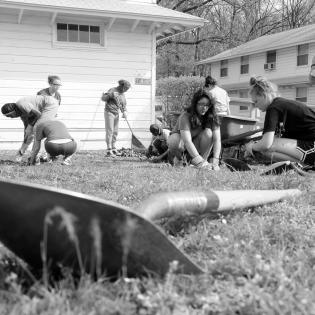Landscape Legacies
We are introduced to The Group of Seven, a group of artists whose intent was to establish a national identity, a sense of pride and an original style for Canada, inspired by the environment. This was a philanthropic endeavor for the common good of all. Participants create similar landscapes of their local community to inspire environmental stewardship.
The learner will:
- describe how art can be philanthropic.
- collaborate for the common good through the arts.
- drawing paper
- art supplies to create color landscapes.
- Group of Seven Art.com: https://groupofsevenart.com/
Instructions
Anticipatory Set:
Display and talk about online reproductions of the landscape paintings created by the Group of Seven to show the beauty of the environment.
These works were created about one hundred years ago by a group of artists in Canada called “The Group of Seven” (Franklin Carmichael, Lawren Harris, A. Y. Jackson, Franz Johnston, Arthur Lismer, J. E. H. MacDonald, and Frederick H. Varley).
This group, who shared a studio in Toronto, was made up of a commercial artist, a wartime illustrator, a teacher, a self-taught artist, and others. The artists would take their canoes out regularly to paint rugged landscapes of Canada. Their intent was to give Canadians a sense of pride in who they were. They had to be strong to survive and that was reflected in their compositions that were strong, simple forms. They felt that Canada, as a new country, should have its own original art and sense of aesthetics, and not try to copy anyone else. They shared their ideas and created art for the common good, or benefit of all. They worked to develop access to art for the common good and rarely were paid for their work.
Define philanthropy as giving time, talent, or treasure for the common good. Define legacy as a perpetual gift without end. These artists created a legacy of environmental art for the common good of the Canadian people.
Art is often an important part of philanthropy: donations and grants often support the arts, and the arts express themes of community. Artists can give us a sense of value not only for who we are, but for how we live in our world.
Challenge youth to do this through their own art, inspired by the simple style of the Group of Seven. They paint or illustrate a picture of the environment – a local landscape - so beautiful that no one would want to destroy the place by either pollution or violence.
These pictures could become the images on greeting cards created for the art-related service project. They may write a statement expressing their concern for the environment on the inside or back of the card.
Philanthropy Framework
-
Strand PHIL.I Definitions of Philanthropy
-
Standard DP 01. Define Philanthropy
-
Benchmark HS.1 Define philanthropy to include giving and sharing; volunteering; and private individual action intended for the common good. Explain how a volunteer individual/group can act for the common good.
-
-
Standard DP 02. Roles of Government, Business, and Philanthropy
-
Benchmark HS.6 Describe how the civil society sector is often the origin of new ideas, projects and innovation and social renewal.
-
-
-
Strand PHIL.II Philanthropy and Civil Society
-
Standard PCS 01. Self, citizenship, and society
-
Benchmark HS.2 Discuss and give examples of why some humans will sacrifice for the benefit of unknown others.
-
Benchmark HS.3 Give examples of human interdependence and explain why group formation is one strategy for survival.
-
Benchmark HS.4 Describe and give examples of characteristics of someone who helps others.
-
Benchmark HS.5 Describe civil society advocacy organizations and their relationship to human rights.
-
-
-
Strand PHIL.III Philanthropy and the Individual
-
Standard PI 01. Reasons for Individual Philanthropy
-
Benchmark HS.1 Define and give examples of motivations for giving and serving.
-
Benchmark HS.3 Describe and compare stewardship in a variety of cultural traditions.
-
Benchmark HS.4 Cite historical examples of citizen actions that affected the common good.
-
-
